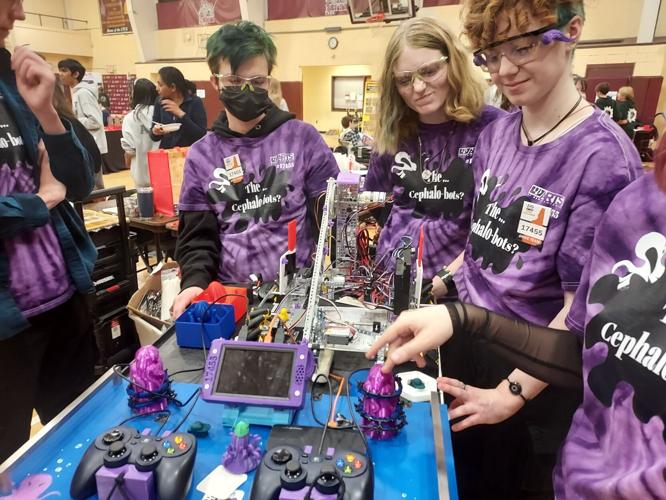Among 28 robots at the FIRST Tech Challenge New Hampshire State Championship, Sir Montgomery Etcetera the Fifth gleamed like an artful piece of engineering.
Its plastic controller cord towers in the shape of purple octopi were fabricated using 3-D printers. A tiny purple octopus wearing a Viking helmet stood between the robot’s box controllers — just for fun. Paintings of octopi — the high school team’s mascot — graced the cart that carried Sir Montgomery to the starting gate.
The robotics team state playoffs were held at NHTI – Concord’s Community College on Saturday. Budding gladiators in engineering from middle and high schools across New Hampshire jockeyed to be one of two teams to advance to the New England regionals — and perhaps to the world event.
In one game, Sir Montgomery launched paper airplanes and ferried plastic pixels, competing against others designed to do the same thing quickly. This robot’s creators, however, fell far outside the stereotype.
“I know a lot of engineering because I get bored and I research things,” said Miles Hewitt, an 11th-grade dance major at Arts Academy of New Hampshire, a public charter high school in Salem. “A motor in the back helps us to keep the arm as long and high as it is.”
“We did our best to integrate art, technology and practicality,” said Quinn Niemi, a senior who is “head of aesthetics” for the Cephalobots, Arts Academy’s robotics team. “Our focus is to show how art and technology can be integrated. My job is to make things look nice.”
It’s a brave new world for art students, and tech is becoming a burgeoning part of it — thanks to FIRST Robotics, a Manchester nonprofit that brings STEM training and competition to 138 schools in New Hampshire. Since 2020, the number of participants in the North County alone has expanded from around 130 to 1,300, said Ken St. Hilaire, a FIRST senior mentor.
STEAM, which stands for science, technology, engineering, art and math, is the latest generation of STEM. It has galvanized students across the Granite State, including those who might fear math and shy away from physical science and programming.
“Now I find robotics really interesting,” said Niemi, a dance, art, music and theater fan who plans to study psychology in college. “It almost breaks down a barrier between art and science.”
She said robotics wasn’t as difficult or as intimidating as she imagined before joining two years ago.
“One person can’t design and build a robot, so there’s a team aspect,” she said. “You hit a lot of roadblocks. You have to have perseverance and be resolved.”
The FIRST advantage
On Saturday, 27 teams from New Hampshire and one from Maine pitted their designs against peers, including a team from Manchester’s Southside Middle School and Team Inconceivable, a group of mostly fifth- and sixth-grade homeschoolers from Peterborough.
George Parker, a sixth-grader on Team Inconceivable, demonstrated how a motor moves a bot’s arm. “We call this the elbow. This is the wrist. This is what we use to pick up pixels,” the shaped plastic disks that the robots need to grab and place.
“It’s fun going to robot competitions and being with the team,” said his fifth-grade sister, Eleanor, who likes to design the paper airplanes.
If she could make a robot now, what would it do? “Put away my clothes,” she said. “I hate doing that.”
Student ideas for future robots ran from high-tech tools to help humans and assist in surgery to improve outcomes, to bots that clean up the environment and reduce CO2 emissions.
Chris Rake, an engineer and chief operating officer at FIRST Robotics, became a volunteer mentor, judge and referee for competitions in Austin, Texas 20 years ago.
”I saw how this program transformed these kids into amazing young adults primed to be the leaders of tomorrow and I fell in love with this mission,” he said.
For some, it’s a spiritual home, said Rake. “We’re a community. We’re fierce competitors but we also support each other. We always say, FIRST is the only sport where every kid can go pro.”
A 10-year study showed that FIRST participants are two to three times more likely to pursue STEM careers than other students. The survey found that 48% of female FIRST students declare a STEM major in college, compared to 16% who were never part of FIRST.
”Kids who are already attracted to this are going to love it,” Rake said. But it also lures “those who say, ‘This isn’t me. I can’t do this. Then they discover it’s something they love.”
FIRST provides a sample, steeped-in-STEM experience for children who might not otherwise have an awareness or an opportunity to try it.
Growing number of teams
In 35 years, FIRST has grown from 33 teams in New Hampshire to more than 80,000 teams and classrooms in 106 countries. Its after-school programs helped combat loneliness during COVID and learning gaps post-pandemic, said FIRST’s chief of operations.
The robotics experience teaches tech skills, communication, collaboration, conflict resolution, how to run a small company and how to manage a budget, he said — “things that are going to help you solve the problems of tomorrow.”
“You are the coolest kids in school and you are awesome,” Patrick Tompkins, president of NHTI – Concord’s Community College, told teams packing the bleachers before the event began. “Engineers run the world. If you couple that with business and accounting, you will own the world.”
”You are learning skills that are going to take you far, and to remote places in your lives,” New Hampshire Education Commissioner Frank Edelblut told the crowd.
”This helps produce the next generation of innovators,” said emcee and head mentor Matt Gage.




























